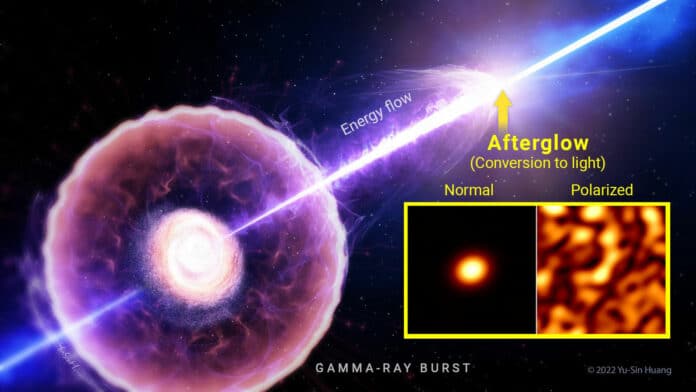Gamma-ray bursts are the most luminous explosions in the universe. They are classified as either short or long, with long gamma-ray bursts resulting from massive stars dying out. In addition to radio waves, optical lights, and X-rays, gamma-ray bursts also release gamma rays. When the conversion of explosion energy to emitted energy, i.e., the conversion efficiency, is high, the total explosion energy can be calculated by simply adding all the emitted energy. But when the conversion efficiency is low or unknown, more than measuring the emitted energy alone is needed.
A team of astrophysicists has now succeeded in measuring a gamma-ray burst‘s hidden energy by utilizing light polarization. When an electromagnetic wave oscillates in only one direction, it is said to be polarised. Although stars don’t emit polarised light, they do reflect polarised light. Polarization is a common technique to reduce glare from light sources moving in a single direction. Examples of these products include sunglasses and light shields.
In astrophysical observations, measuring a celestial object’s polarimetry is not as easy as measuring its brightness. But it offers valuable information on the physical conditions of objects.
The group examined a gamma-ray burst that happened on December 21, 2019. (GRB191221B). They computed the polarimetry of fast-fading emissions from GRB191221B using the Very Large Telescope of the European Southern Observatory and the Atacama Large Millimeter/submillimeter Array. The optical and radio polarisations were then successfully measured simultaneously, and it was discovered that the radio polarisation degree was much lower than the optical one.
Professor Kenji Toma from Tohoku University’s Frontier Research Institute for Interdisciplinary Sciences (FRIS) said, “This difference in polarization at the two wavelengths reveals detailed physical conditions of the gamma-ray burst’s emission region. In particular, it allowed us to measure the previously unmeasurable hidden energy.”
The scientists discovered that the overall energy was around 3.5 times larger than anticipated after considering the hidden energy.
Being able to measure this quantity has significant implications for calculating the masses of stars since the explosion energy represents the gravitational energy of the progenitor star.
Toma said, “Knowing the measurements of the progenitor star’s true masses will help in understanding the universe’s evolutionary history. The first stars in the universe could be discovered if we can detect their long gamma-ray bursts.”
Journal Reference:
- Yuji Urata, Kenji Toma, Stefano Covino, et al. Simultaneous Radio and Optical Polarimetry of GRB 191221B Afterglow. Nature Astronomy. DOI: 10.1038/s41550-022-01832-7
